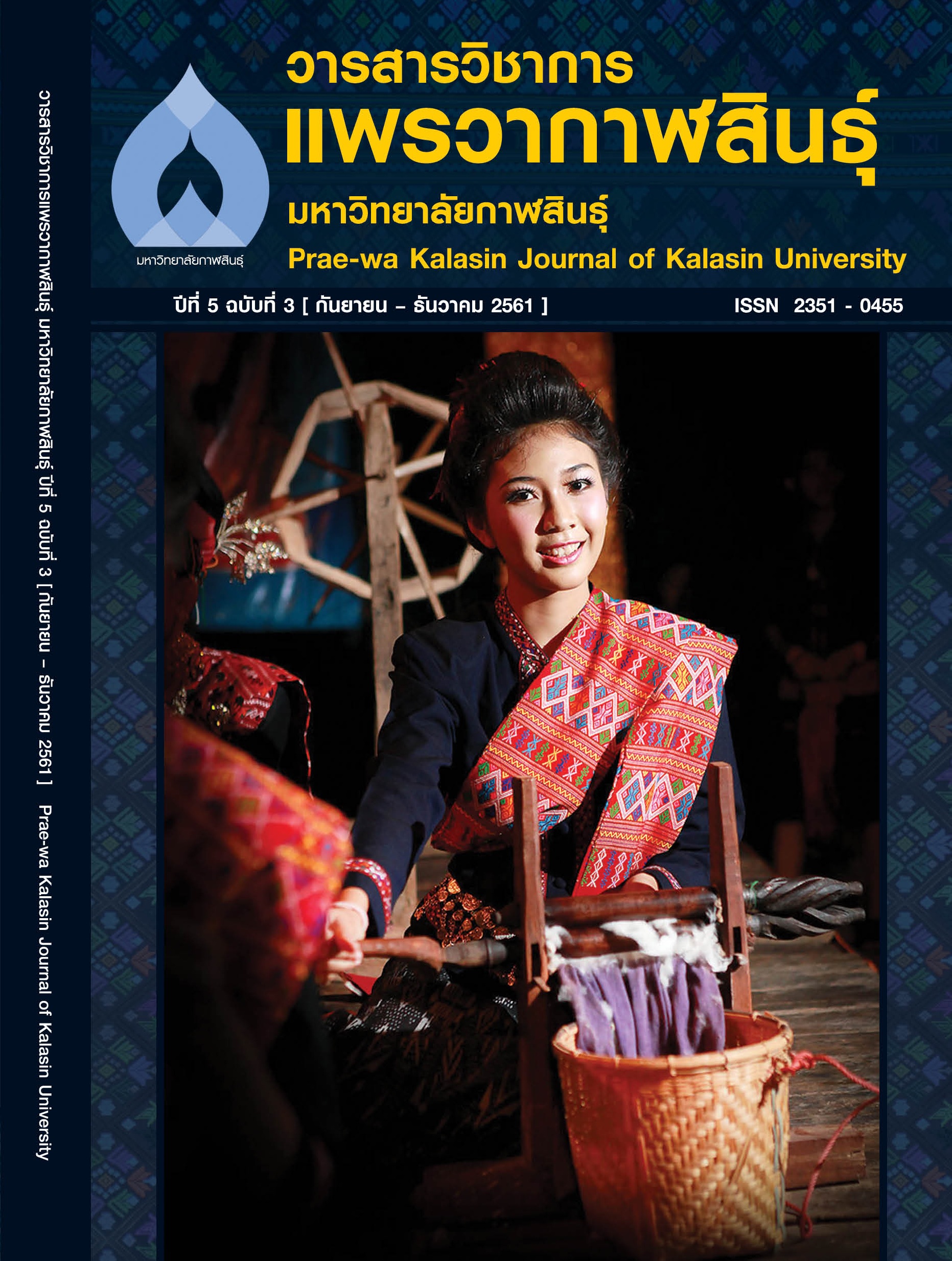Results of Using Tasks to Improve English Speaking, Communication Strategies, Risk Taking of Mattayomsuksa II
Main Article Content
Abstract
The purposes of this research were 1) to develop instructional plans for Mattayomsuksa II students using communicative task activities to meet the required efficiency of 70/70 2) to determine the effectiveness of these English learning activities 3) to compare the learning achievement in English speaking of students who learned through the communicative task activities 4) to study communicative strategies of the students learning through communicative task activities and 5) to study risk taking of the students learning through the communicative task activities. The samples for this research consisted of Mattayomsuksa II students from 2 classes studying in the academic year 2014 at Kalasinpittayasan School in this study was 79 student who were obtained through cluster random sampling. The instruments used in this study were instructional plans, oral test of English speaking skills, a communication strategies evaluation form and a risk-taking behavior observation form. The statistics used for data analyses were means, standard deviation, percentage and t-test. The results of this research are as follows ; 1. The efficiency of the instructional plans are 71.10/73.37 and 74.02/77.32 2. The effectiveness index of the instructional plans are 0.5633 and 0.6297 3. The average score in speaking skills of the students who learned through the Poster Carousel is higher than that of the students who learned through the Headline and Art Gallery at the .05 level of statistical significance. 4. The average scored in communicative strategies are 75.26 and 82.88 respectively. 5. The average scored in risk taking are 76.83 and 82.39 respectively.
Article Details
References
ถวิลรัตน์ สระหอม. (2559). การใช้ภาระงานเพื่อการสื่อสารต่อความสามารถในการพูดภาษาอังกฤษของนักเรียนชั้นมัธยมศึกษา
ปีที่ 3. วิทยานิพนธ์ศิลปศาสตรมหาบัณฑิต. บัณฑิตวิทยาลัย: มหาวิทยาลัยราชภัฎอุดรธานี.
ฟาฏินา วงศ์เลขา. (2553, 7 ธันวาคม). “พัฒนาภาษาอังกฤษเตรียมเด็กไทยสู่อาเซียนและเวทีโลก”. เดลินิวส์รายวัน. น. 3.
วัชราภรณ์ หนูหล่า. (2553). การศึกษาผลสัมฤทธิ์ทางการเรียนภาษาอังกฤษของนักเรียน ชั้นประถมศึกษาปีที่ 5 โดยใช้กิจกรรมภาระงานเพื่อการสื่อสาร. วิทยานิพนธ์ศิลปศาสตรมหาบัณฑิต. บัณฑิตวิทยาลัย: มหาวิทยาลัยราชภัฎอุดรธานี.
สุคนทิพย์ วัฒนามระ. (2539). ผลของการใช้กิจกรรมเน้นงานปฏิบัติที่มีต่อความสามารถในการใช้ภาษาอังกฤษเพื่อการสื่อสารของนักเรียนนายเรืออากาศชั้นปีที่ 2 โรงเรียนนายเรืออากาศ. วิทยานิพนธ์ ครุศาสตรมหาบัณฑิต. บัณฑิตวิทยาลัย: จุฬาลงกรณ์มหาวิทยาลัย.
สุภัทรา อักษรานุเคราะห์. (2539). การใช้กลวิธีเพื่อการสื่อสารกับการสอนภาษาอังกฤษ. กรุงเทพฯ: โรงพิมพ์จุฬาลงกรณ์มหาวิทยาลัย.
สุมิตรา อังควัฒนกุล. (2540). การสอนทักษะทางภาษาและวัฒนธรรม (พิมพ์ครั้งที่ 4). กรุงเทพฯ: โรงพิมพ์จุฬาลงกรณ์มหาวิทยาลัย.
_______. (2539). แนวคิดและเทคนิควิธีการสอนภาษาอังกฤษระดับมัธยมศึกษา. กรุงเทพฯ: โรงพิมพ์จุฬาลงกรณ์มหาวิทยาลัย.
อมร เสือคำ. (2543). “สอนภาษาอังกฤษอย่างไรให้เด็กเรียนรู้”. วารสารวิชาการ, 3(12), 76-78.
อ้อยอัจฉรา สายืน. (2544). การเปรียบเทียบความสามารถในการพูดภาษาอังกฤษ โดยใช้ภาระงานการสื่อสารของนักเรียนชั้นมัธยมศึกษาปีที่ 6 โรงเรียนหนองบัวพิทยาคาร จังหวัดหนองบัวลำภู. วิทยานิพนธ์ศิลปะศาสตรมหาบัณฑิต. บัณฑิตวิทยาลัย: มหาวิทยาลัยราชภัฎอุดรธานี.
Brown, James Dean. (2003). Promoting Fluency in EFL Classroom. Retrieved November 5, 2013, from https://jalt.org/ pansin/2003/HTML/Brown.htm
Nunan, D. (1989). Designing tasks for the communicative classroom. Cambridge University Press.
Nunan, D. (2004). Task-Based Language Teaching. Cambridge University Press.
Tetzner Rene’ F. (2005). Risk-taking by Chinese second language learners of English on an International Foundation Course at a British University. Munich: GRIN Publishing GmbHM.
Thornbury, S. (2005). How to teach speaking. Essex: Longman.
Zafar, Shahila & Meenakshi, K. (2011). A study on the relationship between extroversion-introversion and risk-taking in the context of second language acquisition. International Journal of Research Studies in Language Learning, 1(1), 33-40.

